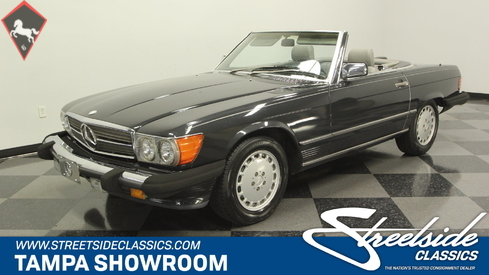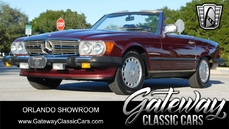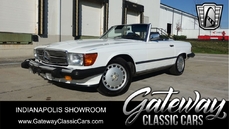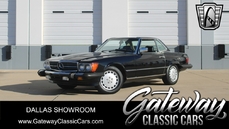Mercedes-Benz 560SL w107 5.6L V8 1987
General description :
ONLY 3 OWNERS, CLEAN HISTORY, ALWAYS A SOUTHERN CAR, RUNS GR8, VALUE PRICED 560
It's hard to believe but true. This classic 1987 Mercedes 560SL offers V8 power, unique features, and is in the perfect color combination... and yet you can get it all for less than an economy car price.
The 560SL is highly desirable because it's the full wish list in one car. These are elegant, powerful, comfortable, timeless and nimble classics. The now legendary R107 model designation are iconic because they represent an era when very few companies could build a convertible without worrying about safety regulations. Mercedes built their cars so robustly that the R107 exceeded these standards, and they did it elegantly without an unsightly roll bar. The Charcoal Gray paint shows signs of being the original application. It has the perfect tone to look contemporary and coordinate with the black convertible top. The gloss and shine this paint retains is a testament to both Mercedes build quality and good care. The same goes for the fit and finish all around this classic convertible.
A great element of subtle elegance is how the sliver pinstripe on the outside is also a preview of the interior color. So this one looks nicely coordinated with the top down – exactly how the SL is meant to be. Plus, the seats, carpeting, and door panels all retain a nice silver presentation. The 560SL was one of the most expensive cars Mercedes offered during its reign, and so the features list is quite long. This includes conveniences such as power windows, power steering, cruise control, an upgraded AM/FM/CD stereo, and provisions for R134a air conditioning. Because this was built 1987, there are also more modern safety features than most R107s, such as anti-lock brakes, a third brake light, and a driver's air bag. You might have also noticed the rear seats with seatbelts. This was not a factory option in the USA, and so it's addition is a rare find on our shores.
The 560SL came with a fuel-injected 5.6-liter V8 motor making 238 hp and 287 lb-ft of torque – more than the contemporary Rolls-Royces. On the road, an R107 has a fully-independent chassis that is the perfect balance of elastic comfort in a tight-handling package. The four-speed automatic transmission knows how to snap to attention under acceleration as well as provide terrific overdrive cruising comfort. This was topped off with four-wheel disc brakes for the best all-around control. In total, the Mercedes SL is in a class all of its own. It has always been hard to define its competitors because no other car combines grand touring comfort with sporty flair so perfectly.
Complete with owner's manual, it's hard not to get excited about complete timeless elegance for far less than the price any new convertible out there. But you're not the only one who sees this, so it won't last long in our showroom. Call today!!!
Features : Driver Airbag, Seatbelts, Power Windows, Power Steering, Power Brakes, Fuel Injection, Four Wheel Disc Brakes, Cruise Control, Vinyl Interior, Heat, Air Conditioning, Manual Convertible Top, Defrost, CD Player, AM/FM Radio
https://www.streetsideclassics.com/vehicles/1419-tpa/1987-mercedes-benz-560sl
1987 Mercedes-Benz 560SL w107 5.6L V8 is listed sold on ClassicDigest in Lutz by Streetside Classics for $11995.
Car Facts
Car type : Car Make : Mercedes-Benz Model : 560SL w107 Model Version : 5.6L V8 Engine size : 5.6 Model Year : 1987 Sub type : Convertible Location : Tampa
Sold
Seller Information
Sold
People who viewed this Mercedes-Benz 560SL w107 also viewed similar Mercedes-Benz listed at ClassicDigest
About Mercedes-Benz
In the annals of automotive history, the journey of Mercedes-Benz is a tale that unfolds with the ingenuity of its founding pioneers. In the year 1886, Karl Benz crafted the Benz Patent Motorwagen, a creation that would go down in history as the world's inaugural automobile. Unbeknownst to him, this moment marked the genesis of what would evolve into the most illustrious premium car manufacturer globally. The financial underpinning of this pioneering venture, interestingly, was provided by Karl Benz's wife, Bertha Benz, demonstrating a remarkable partnership that would set the tone for Mercedes-Benz's legacy.A parallel narrative emerged not far away, as Daimler-Motoren-Gesellschaft, founded by Gottlieb Daimler and Wilhelm Maybach, entered the scene. In 1901, they unveiled their automobile under the now-famous moniker "Mercedes," meaning "godsend" in Spanish. This name was bestowed upon the car at the behest of Emil Jellinek's daughter, the distributor for Daimler-Motoren-Gesellschaft. The wheels of innovation were set in motion.
Fast forward to 1926, a pivotal year that witnessed the merger of Daimler with Benz & Cie., culminating in the birth of Daimler-Benz. The amalgamation saw the adoption of "Mercedes-Benz" as the distinguished trademark for their automobiles, fusing the legacies of two visionary entities into one.
Contrary to perceptions of conservatism, the trajectory of Daimler-Benz unfolds as a chronicle of industry firsts. From the introduction of the honeycomb radiator to the float carburetor, and the pioneering implementation of four-wheel brakes in 1924, Daimler-Benz consistently pushed the boundaries of automotive innovation. The diesel-powered Mercedes-Benz 260 D in 1936 marked the inception of diesel engines in passenger cars. The iconic Mercedes-Benz 300SL Gullwing made history as the first car with direct fuel injection, albeit the Gutbrod's tiny 2-stroke engine can claim precedence.
Safety innovations became a hallmark, with Béla Barényi's patented safety cell design in the "Ponton"-models in 1951, featuring front and rear crumple zones. The W116 450SEL 6.9 saw the introduction of the Anti-Lock Brake system (ABS), another pioneering safety feature. From the first production airbags and beyond, the legacy of "firsts" continued to be etched into the fabric of Daimler-Benz.
Over its centennial journey, Mercedes-Benz has not merely produced cars but has sculpted automotive icons. The SSKL, 710 SSK Trossi Roadster, 770K Grosser, 540K Spezial Roadster, 300SL Gullwing, w100 600 Pullman, w111 280SE 3.5 Flachkühler, w113 230SL Pagoda, w109 300 SEL 6.3, and w201 2.3-16 Cosworth stand testament to the brand's commitment to engineering excellence.
The roaring Silver Arrows, or "Silberpfeile," including the W 25, W 125, W154, W165, and W196, created a legacy of dominance on the racetrack. These machines were not merely cars; they were expressions of precision, speed, and an indomitable spirit that left their competitors in the dust.
As Mercedes-Benz marches into the future, it does so not just as an automaker but as a custodian of a legacy, a torchbearer of innovation, and a beacon of automotive excellence. The road ahead is sure to witness the continued fusion of cutting-edge technology, timeless design, and an unwavering commitment to setting new standards in the world of automobiles.
One luminary figure who left an indelible mark was Béla Barényi, often heralded as the "father of passive safety" for his pioneering work in safety engineering. His patented safety cell design, featuring front and rear crumple zones, became a hallmark of Mercedes-Benz's commitment to occupant safety, setting new standards that reverberated throughout the automotive world.
Moving through the chronicles, the collaborative genius of Wilhelm Maybach, alongside Gottlieb Daimler, laid the foundation for Daimler-Motoren-Gesellschaft. Their innovations not only birthed the first Mercedes but established a culture of relentless pursuit of technological excellence that remains integral to Mercedes-Benz's DNA.
In the post-merger era of 1926, Ferdinand Porsche emerged as a prominent figure within Mercedes-Benz. His work on the Mercedes-Benz S-Type, a supercharged race car, garnered acclaim and set the stage for a legacy that extended far beyond the marque. Porsche's impact would later extend to his eponymous company, but his influence at Mercedes-Benz during those formative years was pivotal.
As the 20th century progressed, the legendary Rudolf Uhlenhaut emerged as a key figure. Uhlenhaut, an accomplished engineer and the driving force behind the iconic Silver Arrows, played a crucial role in Mercedes-Benz's dominance in motorsports. His engineering prowess and attention to detail were instrumental in creating some of the most formidable racing cars of the era.
In the latter half of the century, figures like Bruno Sacco, the head of design at Mercedes-Benz from 1975 to 1999, left an indelible imprint on the brand's aesthetic identity. Sacco's design philosophy, characterized by clean lines and timeless elegance, shaped iconic models like the W126 S-Class and the W201 190E, solidifying Mercedes-Benz's reputation for luxury and sophistication.
The narrative would be incomplete without acknowledging the contributions of engineers like Hans Scherenberg, whose leadership in the 1970s ushered in a new era of technological innovation at Mercedes-Benz. Scherenberg's tenure saw the development of groundbreaking technologies, including the Anti-Lock Brake system (ABS) and the introduction of airbags in production cars.








